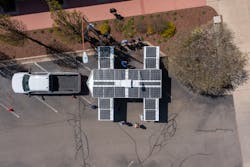After Hurricane Katrina hit the southeastern US in August 2005 — causing more than 1,800 deaths — Lauren Flanagan, CEO and co-founder of nanogrid maker Sesame Solar, decided she had to do something to address the human toll of climate disasters.
“When you have a Katrina-like catastrophe, the government sends out fossil solutions,” she said. But those solutions only compound problems during emergencies, adding noise and air pollution. “The obvious choice is renewable energy.”
She founded Sesame Solar five years ago with a goal of creating a mobile, 100% renewable power option that could be deployed quickly and easily during hurricanes, storms and other emergencies. Another aim was to provide essential services — 5G wireless, clean water, electric vehicle charging and refrigerators for storing medicine.
And Footprint Project, initially a bootstrap operation that is increasingly becoming a presence during humanitarian disasters, has deployed solar microgrids in response to disasters in Louisiana, Ukraine, Texas and other regions.
Sesame Solar has evolved from a solar and storage provider to a 100% renewable nanogrid — plus essential supplies — provider. In Sesame Solar’s first nanogrid efforts, Flanagan deployed solar plus storage to power medical equipment and provide communications and water to regions hit by catastrophe. This worked well in sunny climates like the Carribean. But the solar didn’t run efficiently when smoke from wildfires or clouds filled the sky, said Flanagan.
Avoiding fossil fuels with hydrogen
Instead of adding fossil fuels to the solar and storage — a common backup strategy — Flanagan decided to add green hydrogen to her company’s mobile nanogrids. This is hydrogen produced using renewable energy.
But she faced a number of challenges. Green hydrogen is usually deployed in fixed locations, stored at high pressures and is difficult to transport.
Her company developed a mobile solution that includes solar and storage and creates green hydrogen through electrolysis — inside the nanogrids.
Electrolysis involves using electricity to split water into hydrogen and oxygen. This reaction takes place in a unit called an electrolyzer. Electrolyzers can range in size from appliance-size units to central production facilities tied to renewable or other forms of green electricity production.
In Sesame Solar’s nanogrids, the hydrogen is stored at low pressure — less than the pressure of an aerosol can — and is safe to transport, Flanagan said. The company also designed an energy management system that creates green energy loops. With this system, the solar charges the batteries and when the batteries run down to 35% capacity, the green hydrogen kicks in. The hydrogen is produced while it’s being consumed, said Flanagan.
When the batteries are recharged, the hydrogen operation can shut down. “You can make hydrogen or stop it and toggle into solar mode. You can go back and forth endlessly, you just need sun and water,” she said. With sun and water, the nanogrid can provide off-grid power for days and weeks. The nanogrids generally include seven days’ worth of water for electrolysis, but when that’s used up, the units also include water filtration systems that can clean whatever water is available enough so that it’s suitable for electrolysis. But with enough solar, it may not be necessary to create extra green hydrogen, Flanagan said.
Moving the nanogrid
Designed to be up and producing power quickly, the nanogrids can be transported by tandem trailers or flatbed trailers, or transported by helicopter in containers. Sesame Solar’s plan is to use electric trucks — the Ford Lightning F-150 or a Rivian electric truck — to ensure the operation is 100% renewable. The company has ordered one of each of those trucks. They can be charged with a charger on board the nanogrid. “We can move the nanogrid without using the grid or a gas station,” she said.
The nanogrids include how-to videos about setting up and using the units. In the future, the nanogrids will also include a 5G wireless network that will connect through local cell towers and allow 20 or 30 people to access it at once. This network operates mostly within the nanogrid, said Flanagan.
Small wind turbines of 1.5 kW to 2 kW can be added to the nanogrid.
Open sesame
Sesame Solar’s name is based on the nanogrid’s ability to open up, revealing retractable solar photovoltaic panels on each side and the roof, said Flanagan.
“We say “Open sesame” and the treasure of essential services is inside,” she said. “It opens up so you have not only rooftop solar but interior walls with solar panels. And it all folds back into a trailer or container; the design gives us more real estate for solar.”
The Sesame Solar nanogrid was deployed on the island of Dominica in the wake of Hurricane Maria to provide backup for medical facilities. Cox Communications has a small version of Sesame Solar’s nanogrid in a towable trailer that’s used to help keep community members connected during emergencies. If there’s an outage, the nanogrid is placed in parks or community centers to provide a place for residents to charge their phones.
And for internet provider Comcast, Sesame Solar has created crisis response centers, including two nanogrids in Louisiana after Hurricane Ida devastated the area.
Power within 15 minutes of arrival
The idea is to provide emergency power and services on the go, in fact, within 15 minutes of arriving on the scene of a crisis.
“It’s all set up so solar is there when you open it up. You push a button, open up and have power. This avoids the need for ground mounting and connections. Anyone can do it and anywhere,” said Flanagan.
Track news about mobile nanogrids. Subscribe to the free Microgrid Knowledge Newsletter.








